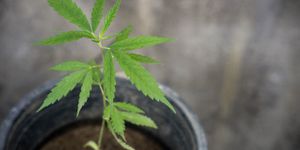Study Provides Insights Into Cannabis Productivity
A study published in Horticulture Research identified a key gene known as CsMIKC1 that controls the number of flowering cannabis bud sites. The study examined how CsMIKC1 impacts cannabis flower or inflorescence development. The finding could lead to cannabis cultivation innovations that optimize bud productivity.
The researchers used CRISPR-Cas9 gene editing and functional analysis to assess how CsMIKC1’s mutations and overexpression shape bud development. The study concluded that CsMIKC1 functions as a pivotal regulator of inflorescence development. CsMIKC1 is a MIKC type of MADS-box transcription factor. MIKC stands for MADS, intervening, keratin-like, and C-terminal. A MADS-box transcription factor means that contains the following attributes: mini-chromosome maintenance factor from Saccharomyces cerevisiae, Agamose from Arabidopsis thaliana, Deficiens from Antirrhinum majus, and S Serum Response Factor (SRF).
The study identified a primary quantitative trait locus (QTL) on chromosome 8 linked to the bud number per branch, which consequently resulted in the discovery of the CsMIKC1 gene. This gene acts as a transcription factor that regulates inflorescence development by interacting with proteins CsBPC2 and CsVIP3. The study showed that plants overexpressing CsMIKC1 produced more buds. According to study co-author Dr. Jianguang Su, “The identification of CsMIKC1 as a regulator of inflorescence development marks a significant step forward in Cannabis genetics. This gene is crucial in determining flower yield, which has profound implications for both medicinal and industrial uses. By utilizing genetic modification techniques, we can develop targeted approaches to optimize crop performance, enhancing the Cannabis industry’s potential.” This study provides a foundation for further research exploring gene factors promoting more effective cultivation practices for achieving high-yielding strains.
The study also revealed that ethylene signaling pathways influence CsMIKC1. The research team noted reduced ethylene sensitivity of CsBPC2 mutants. One finding showed that the application of external ethylene triggered CsMIKC1 expression. The study provided a comprehensive genetic network map based on identifying genes regulated by CsMIKC1.
The discovery of CsMIKC1’s influence on inflorescence development offers a new target for genetic engineering to boost cannabis yields. This knowledge could drive the creation of novel cultivars with improved flower and grain production, maximizing farming efficiency. Furthermore, the involvement of ethylene signaling pathways presents opportunities for refined agronomic practices, such as ethylene treatments, to further increase flower yield. These advances hold significant promise for scaling up Cannabis production to meet the growing demand for medicinal and industrial applications worldwide.
Sources: Eureka News Alert, Horticulture Research








